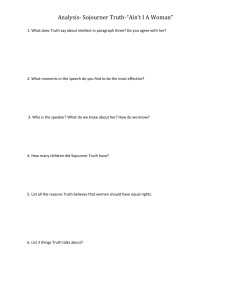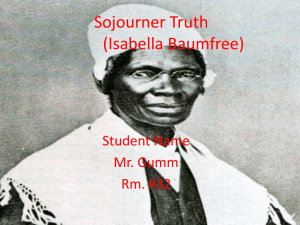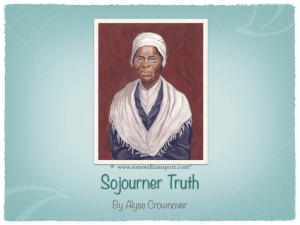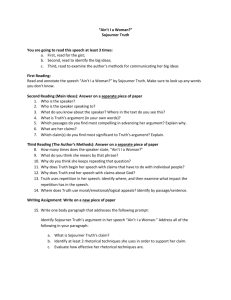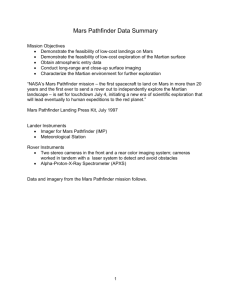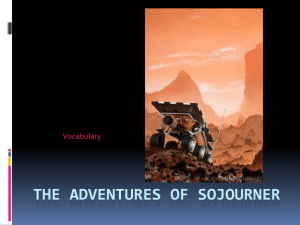The Adventures of Sojourner
advertisement
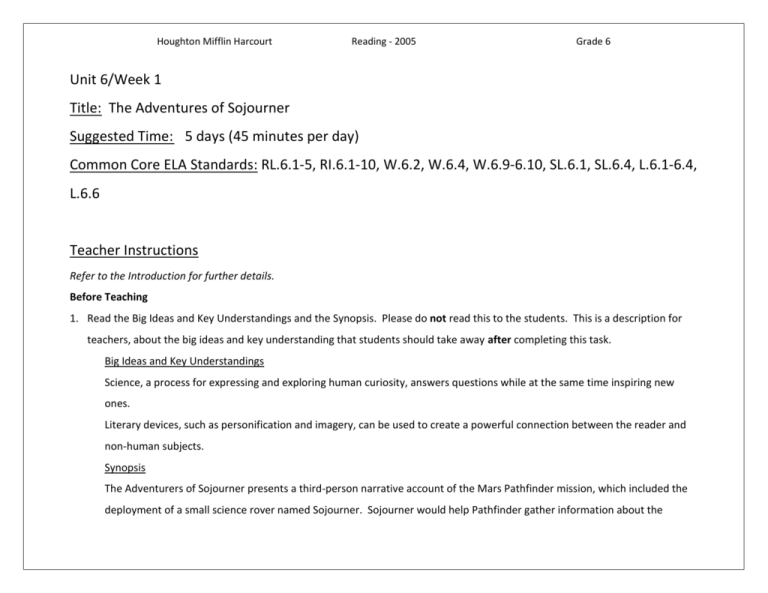
Houghton Mifflin Harcourt Reading - 2005 Grade 6 Unit 6/Week 1 Title: The Adventures of Sojourner Suggested Time: 5 days (45 minutes per day) Common Core ELA Standards: RL.6.1-5, RI.6.1-10, W.6.2, W.6.4, W.6.9-6.10, SL.6.1, SL.6.4, L.6.1-6.4, L.6.6 Teacher Instructions Refer to the Introduction for further details. Before Teaching 1. Read the Big Ideas and Key Understandings and the Synopsis. Please do not read this to the students. This is a description for teachers, about the big ideas and key understanding that students should take away after completing this task. Big Ideas and Key Understandings Science, a process for expressing and exploring human curiosity, answers questions while at the same time inspiring new ones. Literary devices, such as personification and imagery, can be used to create a powerful connection between the reader and non-human subjects. Synopsis The Adventurers of Sojourner presents a third-person narrative account of the Mars Pathfinder mission, which included the deployment of a small science rover named Sojourner. Sojourner would help Pathfinder gather information about the Houghton Mifflin Harcourt Reading - 2005 Grade 6 planet’s surface. Although the Pathfinder mission was scheduled to last one month, the small rover was expected to have only a week’s longevity. Surprisingly Sojourner outlasted Pathfinder, which lose communication with NASA on Sol 83 (the 83rd Martian day of its journey). Throughout the entire exploration, the lander, rover and mission personnel at NASA were able to examine several rock formations on the planet’s surface. The results of these studies surprised mission scientists very much and paved the way for new, similar projects in the future. 2. Read entire main selection text, keeping in mind the Big Ideas and Key Understandings. 3. Re-read the main selection text while noting the stopping points for the Text Dependent Questions and teaching Vocabulary. During Teaching 1. Students read the entire main selection text independently. 2. Teacher reads the main selection text aloud with students following along. (Depending on how complex the text is and the amount of support needed by students, the teacher may choose to reverse the order of steps 1 and 2.) 3. Students and teacher re-read the text while stopping to respond to and discuss the questions and returning to the text. A variety of methods can be used to structure the reading and discussion (i.e.: whole class discussion, think-pair-share, independent written response, group work, etc.) Text Dependent Questions Text Dependent Questions Reread the first seven paragraphs on p. 551. The author switches from an informative writing style to a narrative (story telling) style. Where does this transition start? At what point does it end? What text features help to emphasize the transition? Answers The transition begins in the third paragraph when she questions the reader, then invites him/her to imagine they are present on Mars. The transition to narrative concludes when the author states, “in the Mission Operations room.” All text after that point is in the third person narration, where as the Houghton Mifflin Harcourt Reading - 2005 On p. 551, as the author describes the opening of Pathfinder’s parachute, what comparison does she make? Why does she choose this comparison historically and literally? As Pathfinder makes its final landing on Mars, airbags protect it from violent impact. What image does the author use to help the reader understand this technical procedure? P. 555 Reread page 555. What words does the author use to reveal the feelings of the different mission personnel on Earth after the Pathfinder landing? How does the author explain these differences? Personification is when a non-human subject is given attributes of a living thing. On p 555, which words does the author use to help create the perception of Sojourner as human? Symbiosis describes a relationship in which two people exist together because they depend on each other to satisfy a need or needs. Reread pp. 555-556. Does this word apply to the relationship between Sojourner and the NASA team? Why or why not? Grade 6 text before is conversational in tone. The indented line after the questioning set and the change of font also indicate the shift of style. The author compares the explosions that control the landing process to fireworks on Independence Day. This comparison is relevant because the lander reached the moon on July 4th, American’s Independence Day. The comparison is also made because fireworks are also created by explosions and are generally loud as the Pathfinder must have also been. The author compares the landing spacecraft to a “giant beach ball.” The mission commander is happy as are most of the scientists and engineers. Their dream of landing a craft on Mars was realized. The mission geologist is worried because he is not yet certain that his dreams, the study of actual rocks will come true, because there are not yet images being transmitted from the lander. The pronoun “she” is used to identify the rover. She “gathered herself up to her full 12 inch height” makes her seem childlike—or like Wall-E, which as it turns out was based on Sojourner!). The author also says, “Sojourner got to work” when actually the scientists at NASA controlled it remotely. She also left “imprints” (footprints) in the soil “trailing behind.” Answers may indicate a one-sided relationship with NASA personnel using Sojourner to meet a need or set of needs (i.e. analyzing rock samples and transmitting pictures. Other answers may recognize mutual dependence. Sojourner needing direction and input from NASA, but NASA could not provide that direction or insight without the information Sojourner was sending back to NASA. The author says Houghton Mifflin Harcourt Reading - 2005 Reread p. 556-667, where the author states, “In keeping with the spirit of the mission, thought, everyone agreed to release the photos immediately.” What can we infer about the spirit of the mission from this decision? What other evidence in the text indicates this spirit? How did the hazard avoidance system enable Sojourner to become more independent? What other systems helped her grow up during the course of her travels on Mars? P. 559 Scientists expected Sojourner to function in the harsh Mars climate for 7 days. How long did she actually function? What organizational structure used by the author helps the reader determine this? P. 560 Reread p. 562. The author describes what may have been the last experiences of Sojourner on Mars and the decision of the NASA team to end the mission. What words or phrases reveal the tone of these paragraphs to the reader? What information does the author give to show Sojourner’s legacy, or what she left behind? (p. 562) Grade 6 Sojourner “helped Brian Cooper.” This statement follows a statement that scientists usually hold off on sharing data until they have analyzed it. This departure from normal practice must mean that the spirit of the mission could be said to be openness, curiosity, new frontiers, knowledge… anything that recognizes the importance of sharing the experience. Further evidence shows in the open chat rooms, webcams and access to information from Mars available on the mission website. The hazard avoidance system allowed Sojourner to move around under her own control. She also used a laser location system to find the objects she needed to sample. The actual time Sojourner remained functional at least 74 Sols; it is not possible to determine an actual end date for the rover because the lander ceased functioning before Sojourner. The author organizes the text by marking time in Sols. “On Sol 83” the last full transmission was sent to Earth from Pathfinder. The tone is lonely or sad. The author says that Sojourner “repeatedly asked for command from Earth, but there would have been no reply.” The team “reluctantly” ends the mission and “would still try once a month to pick up a signal.” The author recaps the important learning that occurred thanks to her investigations, and connects her research to future possibilities for research. Houghton Mifflin Harcourt Reading - 2005 Grade 6 Vocabulary STUDENTS FIGURE OUT THE MEANING sufficient context clues are provided in the text TEACHER PROVIDES DEFINITION not enough contextual clues provided in the text KEY WORDS ESSENTIAL TO UNDERSTANDING Bermuda Triangle, p. 560 descent, p. 551 imprints, p. 555 protruding, p. 557 halted, p. 558 WORDS WORTH KNOWING General teaching suggestions are provided in the Introduction tether, p. 551 propulsion, p. 551 array, p. 555 complex, p. 551 detached, p. 551 faint, p. 553 unconventional, p. 553 retracted, p. 554 offending, p. 554 accustomed, p. 554 hazards, p. 556 encrusted, p. 557 avoidance, p. 559 uncontaminated, p. 560 sufficient, p. 561 reluctantly, p. 562 relatively, p. 562 Houghton Mifflin Harcourt Reading - 2005 Grade 6 Culminating Task Re-Read, Think, Discuss, Write Sojourner was a machine; however, throughout the text the author uses language to create particular connections between the reader and the rover. Discuss at least three examples of this language use, and explain the effect this language is intended to have. Answer: Strong answers will include references to personification or images that are evocative of emotion. Example: “It was less a ‘so long’ than a ‘see you later.’” This phrase shows a connection between NASA and the machine that is indicative of familiarity and hope for future relationship. It is intended to show a bond between them. Of course several examples were discussed in the selection questions and any of those would be acceptable as well. Additional Tasks A sojourn is a temporary stay somewhere. Using details from the text explain why Sojourner is an appropriate name for the Mars Rover, and why it may also be misapplied. Answer: Sojourner’s name was fitting because she was a visitor to a new place, and her work was temporary. However, her name may not have been appropriate because she managed to out-stay her expected visit by 10 times it’s length, or because she never left the planet. When Earth lost contact with Pathfinder, neither vehicle was recovered. Careful planning is involved with using sophisticated technologies, especially in space. Create a poster highlighting the features of Sojourner that show careful problem solving and planning on the part of NASA scientists. Houghton Mifflin Harcourt Reading - 2005 Grade 6 Note to Teacher By juxtaposing questions about the science of the mission and the author’s choice of genre and treatment of the rover, this set of questions illuminates the powerful personification to create a connection between the reader and what might otherwise be a rather dry reporting of facts.
